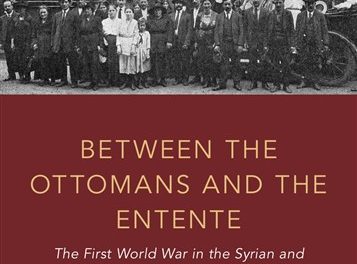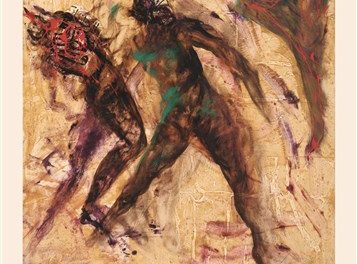Golbarg Rekabtalaei, Iranian Cosmopolitanism: A Cinematic History (Cambridge: Cambridge University Press, 2019).
Jadaliyya (J): What made you write this book?
Golbarg Rekabtalaei (GR): For as long as I remember, I have had an avid interest in Iranian cinema. However, when I migrated from Iran, my interest began to grow—perhaps as a means for me to connect with the country that I had left behind as an adolescent and to come to terms with my new life in the diaspora. Most of the films that I used to watch before I started my graduate program were post-revolutionary films, part of what is commonly known as the Iranian New Cinema, a post-revolutionary movement that solidified after the Iran-Iraq war of the 1980s. From the mid-1990s onwards, Iranian films began to gain much international acclaim, and that is when I became interested in understanding the success of these films on an international level. However, as I began my research on Iranian cinema of the post-revolutionary era in my MA program, I realized that I needed to go back further in time to better comprehend the current state of this cultural form. As I delved more into the past, I became more conscious of the cosmopolitanism of Iranian cinema before the revolution, as well as the heterogeneous social conditions and hybrid identities that facilitated this cosmopolitanism. And like that, I started writing my PhD dissertation on the cinema of pre-revolutionary era—a project that culminated in the form of the book at hand.
J: What particular topics, issues, and literatures does the book address?
GR: Due to its geopolitical position and tumultuous history in the nineteenth and twentieth centuries, much of the history of Iran is overdetermined by a political periodization that amplifies ruptures. In other words, politics is often seen as determining the temporality of culture, society, economy, etc. Iranian Cosmopolitanism decouples the history of cinema from political history, by investigating continuities and discontinuities in the history of cinema in Iran, while at the same time situating its transformations within larger international and national debates. Through its focus on cinematic temporality (rather than on a strictly political one), the book reveals a different periodization and narrative of cinema in Iran.
To give you an example, the book attends to an overlooked era in the history of cinema in Iran. Since the first Persian-language films (or what is generally regarded as “national” cinema) were produced in the late 1920s and early 1930s, the history of cinema in Iran prior to this period has been largely ignored. It is commonly held that cinema was unpopular during this period due to the religious establishment’s disapproval of the technology, or because it was utilized by colonial agents in the service of imperialism and neocolonialism in the first two decades of the twentieth century. Going beyond such explanations that place much significance on the agency of European powers, Iranian Cosmopolitanism examines the role of cosmopolitan cinema owners/operators, the space of cinema, and international films in shaping a vernacular modernity and contributing to a diverse urban culture in the early twentieth century. The heterogeneous cinematic culture that was engendered during this period came to bear a cosmopolitan character upon Iranian cinema in the decades that followed. It seems to me that the configuration of such highly diverse conditions was central to the shaping of nationalist sentiments and a national cinema in the early decades of the twentieth century. In other words, as the book shows, for the most part, cosmopolitanism went hand in hand with nationalism.
J: How does this book connect to and/or depart from your previous work?
GR: I consider myself a cultural historian of modern Iran, and I am generally interested in the social and cultural cosmopolitan conditions and transnational interactions that have shaped Iranian cinema. This is my first book and it is the culmination of the research that I carried out throughout my PhD program. Some of this research, connected to the theme of cinematic cosmopolitanism, has appeared, in more detail, in the form of independent articles. For example, in an article that I published in Iranian Studies, I explore the ways in which the alternative cinema of pre-revolutionary cinema, commonly known as Iran’s New Wave cinema, engaged with international cinematic movements such as Italian neorealism, French New Wave, and Third Cinema, in addition to global political sentiments of the 1960s and 1970s. Such dynamic engagements and dialogue among filmmakers, producers, film critics, and film enthusiasts contributed to the formation of a vernacular cosmopolitan cinematic movement in Iran that set itself apart from the popular cinema of the era. Sublimating the political tensions of the pre-revolutionary era, this alternative cinema gave rise to a revolution in cinema (in form and onscreen) prior to the 1979 political revolution of Iran.
In another article, I explore the shaping of a sovereign (“national”) cinema in the 1920s and 1930s. This article challenges the argument that cinema was ostracized by the religious establishment based on Islamic condemnation of figural depiction of humans. I demonstrate that cinema was widely employed by people from diverse ethnic, linguistic, and religious backgrounds as an educational tool to promote “social morality” and stir nationalist sentiments. In other words, Iran’s cosmopolitan film operators and cinema owners were central in shaping nationalism in Iran before it was co-opted by the newly-formed Pahlavi state in the 1930s. Incorporating cinema into nationalist discourses on education in Iran, the Pahlavi Dynasty then took over cinema as an extension of the government’s technologies of power and discipline in the interwar period. In my book, I further trace the connection between the state and Iranian cinema during and after World War II.
J: Who do you hope will read this book, and what sort of impact would you like it to have?
GR: The book is an interdisciplinary project that poses cinema as a prism through which the history of modern Iran can be investigated. As such, I think the intended audience for the book includes both students and scholars of the modern history of Iran and the Middle East at large, as well as Iranian cinema (and Middle Eastern cinema). For its theoretical framework, the book would also be of interest to those who work on cosmopolitanism in the Middle East.
In terms of impact, by providing different sets of social and cultural networks, this book contributes to discussions that rethink centers and peripheries of modernity. Very few studies have dealt with transnational exchanges and heterogeneous cultural dynamics that contributed to urban modernity in Tehran in the early twentieth century. Therefore, this project adds Tehran to other hubs of modernity in the Middle East and North Africa such as Cairo and Istanbul. In that sense, the book also aims to add to the historiography of cosmopolitanism in the Middle East, and transnational exchanges throughout the twentieth century.
J: What other projects are you working on now?
GR: I am currently working on a few articles that all relate to the transnational history of early cinema in Iran. One of these attends to international silent and early talking fiction films and newsreels that made Iran the main subject of their films from 1900s to 1930s. I find it fascinating how the Great Powers’ portrayal of Iran in propaganda films and newsreels (in particular in German, British, and Russian films) was illustrative of their political agendas, especially evident in their policies towards Iran.
I have also started working on a second book project on youth and youth culture in the late Qajar and early Pahlavi (early to mid-twentieth century) Iran. I am interested in investigating how the youth were approached and co-opted by cultural trendsetters, social critics, and various governments for the nationalist projects that were undertaken in this era. I am also intrigued by how the youth responded to the ways in which they were to be disciplined as Iran’s future-makers. Many of the youth who were members of state-sponsored youth and school groups later became critics of the government and got involved in socialist political groups that worked to undermine the Pahlavi state.
Excerpt from the Book
From the introduction:
An empire at the turn of the century, Iran was home to various ethnic groups such as (Azerbaijani) Turks, Kurds, Lurs, Baluchis and Arabs, and different religious communities, such as Muslims, Jews, Zoroastrians and Christians, who lived under the sovereignty of the Persian Empire. Nevertheless, toward the end of the nineteenth century and in the early twentieth century, ever-increasing numbers of war-ridden neighbouring communities chose Iran as their new national home, while a large number of Iranian merchants, political figures, students, journalists and workers also travelled back and forth to the neighbouring regions and beyond. Many members of ethnic, religious and linguistic groups, such as Armenian, Azerbaijani, Georgian and Russian communities, along with Indian, American, French, German and British peoples, congregated in Tehran. The aforementioned groups conceived the growing urban centre as either a safe haven from socio-political pressures that had compelled them to migrate from the empires or newly founded states in which they previously resided, or as a suitable centre for cultural and commercial activities, or alternatively as a fertile locus for the actualization of colonial and imperial aspirations. The increased assembly and interaction of these communities in Tehran turned the city into a diasporic hub of highly diverse national, ethnic, religious and linguistic communities.
I call Tehran “diasporic” to highlight it as a “site for mixed and hybrid identities”; to bring to the foreground the conditions made possible for “mobility and mobilization,” “trade and merchants,” “migrants and diasporas” and “travellers and communication,” conditions that allowed for novel encounters and practices. The social and cultural exchanges of diverse groups led to the formation of experiences that, following Stuart Hall, could only be defined “by the recognition of a necessary heterogeneity and diversity; by a conception of ‘identity’ which lives through, not despite, difference; by hybridity.” The diasporic communities who resided in Tehran had diverse, urban, middle-class cultural habits which included a vigorous engagement with newspapers, photography, theatre, music gatherings, conferences and charity events – societal conventions that further contributed to the city’s cultural assortment at the turn of the century. Such social and cultural heterogeneity, to borrow from Gerrard Delanty, was not reducible to “cultural diversity,” but was a “product of transnational movements” of people, cultures and ideas, and was marked by “hybridity.”
I choose Tehran as the site of my social and cinematic analysis largely because Tehran was arguably the Bombay of Bollywood or Hindi Cinema. It was the location of many of the sustained film productions that began in the late 1940s, as well as the hub for the publication of film journals, the organization of film festivals and cinematic activities that shaped the “national” cinema of the country. Furthermore, as mentioned before, it hosted a large number of people from different ethno-religious and cultural groups, and facilitated “geographies of coexistence,” which all together conjured conditions of social cosmopolitanism in the city and beyond.
When considering its connection to early twentieth century societal changes in Tehran, cinema proves to be an ideal form to investigate cosmopolitanism. Early cinematograph owners and operators were members of diasporic communities and/or merchants, who by virtue of their trade and travels, were informed of latest technological devices and gadgets outside Iran. The early cinematographic screenings that these trendsetters organized in urban districts facilitated interactions between Tehran’s diverse communities. Moreover, the images that films projected provided opportunities to encounter and register difference. Cinema’s technology, moreover, allowed for the articulation of local experiences that could speak on a global level. As a cultural “site of tension,” a “space of new dynamics, interactive moments, and conflicting principles and orientations,” a site where traumas of and negotiations with modernity could be recorded and staged, early cinema opened new avenues to perceive the world and understand the self. This quality of cinema is indicative of its “reflexive relation” with Iranian cosmopolitan modernity, especially in the context of early twentieth century Tehran.
—
The cosmopolitan cinematic culture that was engendered through the dynamic activities of the early cinematograph operator-merchants came to bear a cosmo-national character upon the first Persian-language films that were produced and screened in Iranian theatres in the 1930s. The emergent cinema of the 1930s was shaped by cosmopolitan filmmakers who entertained nationalist sentiments in their visual offerings. The subsequent “national” cinema that emerged in the late 1940s, after World War II, and continued to the late 1970s was likewise informed by Iran’s heterogeneous culture, insofar as it engaged cosmopolitan filmmakers and conversed with international cinematic trends. By probing into the early cinema’s cultural practices, cosmo-national film industry of the 1930s and cinematic productions that ensued in the decades prior to the 1979 Revolution, this book shows that cinema is an advantageous form to investigate Iranian cosmopolitanism; on the other hand, cosmopolitanism is a valuable interpretive category through which one could interrogate Iranian modernity. Viewed through the prism of cinema, for much of the twentieth century, Iranian modernity was the sum of contentious viewpoints that negotiated and competed between local/global, traditional/modern, old/new, ideological/spiritual and national/international tendencies.
—
Although commonly and sometimes haphazardly used in academia and popular narratives, cosmopolitanism escapes easy definition. The cosmopolitanism of interest to this project cannot be seen in light of globalization, especially since, in the context of Iran, cosmopolitanism was a socio-cultural agent in societal transformations before the processes of globalization were at play. It is neither associated with political accounts nor with a Universalistculture as originally set out by the tradition of Kant in modern cosmopolitan thought. I am interested in a cosmopolitanism that “takes as its point of departure different kinds of modernity and processes of societal transformation” that do not “postulate a single world culture.” Not defined in terms of a single notion of (European) modernity, this cosmopolitanism rejects theories of “Westernization.” Upholding “the temporal assumption of the non-contemporaneity of European and non-European societies,” Eurocentric accounts associate modernity with a “European narrative of progress” that overlooks local experiences, “ideas, institutions, intellectuals, and processes which function as a bridge between the local and global, tradition and change.” Cosmopolitanism, on the other hand, conceived as “an opening to the world,” a process in which the universal and the particular, the similar and dissimilar, the global and the local are to be conceived as interrelated and reciprocally interpenetrating principles, demands “the opening up of normative questions.” Considering it not as an “orientation” that focuses on a specific social form, but as an imagination that can take the shape of “many different forms,” cosmopolitanism provides an avenue to analyze the interstitial spaces and practices that defined the contestatory and competing experiences of modernity in Iran.
An inquiry into conditions of cosmopolitanism underpinned by cinematic experiences also offers a stimulating foray into the shaping of nationalism and national imagination in Iran. No matter how “educationally, genetically, economically, juridicially, socially, militarily, cartographically, or otherwise imposed or inculcated” nationalism and national identity are, David Yaghoubian reminds us, it is the people from different classes, races, ethnicities, religious and linguistic backgrounds who are “the producers, bearers, and interpreters” of these concepts. As the following chapters demonstrate, the experience of compound identities, their quotidian cultural practices and their ways of life become indispensable to the configuration of nationalism, especially in early-twentieth-century cosmopolitan Tehran. As cultural products, Iranian filmic offerings also drew on global tropes, figures, icons, visual grammar and motifs in the creation of national, and at times, nationalist, films. In other words, Iran’s national cinema was arguably a cosmopolitan construct; by facilitating encounters with difference and interactions with global cinematic cultures, it opened up new outlooks on the world and new opportunities for understanding national selves. Cosmopolitanism, I demonstrate throughout this book, was arguably a style of national imagination.
_____________________________
This article is part of the new Jadaliyya Iran Page launch. To inaugurate the Iran Page, its co-editors are pleased to present the following articles, interviews, and resources:
Articles
“Jadaliyya Launches New Iran Page” by Iran Page Editors
“Covering Race and Rebellion” by Naveed Mansoori
“The Systemic Problem of ‘Iran Expertise’ in Washington” by Negar Razavi
Media Roundup
New Texts Out Now (NEWTON) Interviews
Nile Green, The Persianate World: The Frontiers of a Eurasian Lingua Franca
Narges Bajoghli, Iran Reframed: Anxieties of Power in the Islamic Republic
Eskandar Sadeghi-Boroujerdi, Revolution and its Discontents: Political Thought and Reform in Iran
Golbarg Rekabtalaei, Iranian Cosmopolitanism: A Cinematic History
Peyman Vahabzadeh, A Rebel’s Journey: Mostafa Sho‘aiyan and Revolutionary Theory in Iran
Resources
Jadaliyya Talks: Arash Davari and Sina Rahmani on “Divorce, Iran-America Style”
“Essential Readings: Post-Revolutionary Iran” by Arang Keshavarzian











